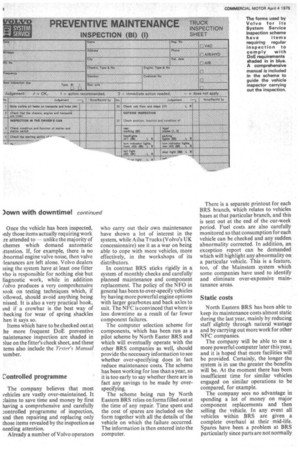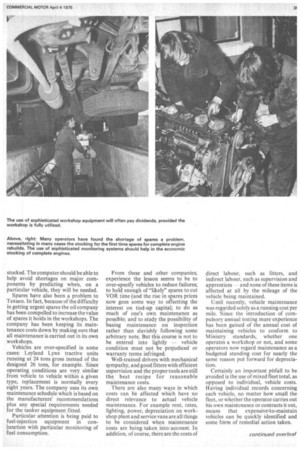Down with downtime!
Page 35

Page 36

Page 37

If you've noticed an error in this article please click here to report it so we can fix it.
Containing maintenance costs without letting vehicle standara slip calls for close monitoring
by Tim Hoare
MAINTENANCE comes second only to fuel when calculating the running costs of a vehicle. As an example, the maintenance costs of a 16-ton rigid covering 60,000 miles per year would last year have been upwards of £2,300.
There have been plenty of incentives during the past year for trying to reduce these maintenance and repair costs, for not only have spares been scarce (and downtime is expensive) but their price has increased at almost monthly intervals.
The way different companies and undertakings have been tackling the problem is interesting. Bass Charrington, for example, is a great exponent of the "if it is unnecessary, leave it offtheory and as a result has been able to save about £2,000 per year on light bulbs!
The company decided that since its tractive units were rarely running solo it was unnecessary to have rear lamps fitted to them. After a check with the DoE, the lamps were removed and a saving of £1000 made. For the odd occasion when one of these urban tractive units is used on its own a special board, complete with lamps, is fitted and connected temporarily to the rear of the vehicle. Bass Charrington uses the Mainstenn system of cost monitoring.
Brake linings
The company has been able to make substantial savings in brake linings too. The wear rate on some tractive units was considered unsatisfactory and, after approaches to the vehicle manufacturer has resulted in nothing, Bass Charrington got in contact with the lining manufacturer. As a result the front brakes are now fitted with a new lining material, different from either of the two materials offered by the vehicle manufacturer but which have improved wear rate by some 400 per cent, together with an improvement of on-road performance. As a time-saver Churchill wheel trolleys are used to remove the wheel assembly and drum as one for any brake work. A philosophy of leaving well alone the basis of Volvo's System Servi which has been available at Vol' distributors since January 1 this yet The scheme has been used Scandinavia for some years and it claimed that cost savings of up to 60p cent have been achieved. In this count there has been insufficient time for feed-back of information. Alt operating conditions are very differet and some aspects of the system have lu to be modified in order to comply wi DoE requirements for operato licensing.
The system relies on two ye thorough 41/2-hour workshc inspections and one addition inspection annually, not forgettii preventive maintenance inspectio whose frequency is determined by f operating conditions of the vehicle. T. service inspections are carried out on time basis, but lubrication is done in t: conventional manner with oil and fat changes at specified mileage interval; Once the vehicle has been inspected, ifly those items actually requiring work .re attended to unlike the majority of chemes which demand automatic gentian. If, for example, there is no .bnormal engine valve noise, then valve learances are left alone. Volvo dealers 'sing the system have at least one fitter vho is responsible for nothing else but liagnostic work, while in addition icily° produces a very comprehensive )ook on testing techniques which, if 'ollowed, should avoid anything being nissed. It is also a very practical book, tnd if a crowbar is the best way of :hecking for wear of spring shackles hen it says so.
Items which have to be checked out at he more frequent DoE preventive. naintenance inspection are shaded in )lue on the fitter's check sheet, and these tems also include the Tesler's' Manual -lumber.
Controlled programme The company believes that most vehicles are vastly over-maintained. It claims to save time and money by first having a comprehensive and carefully controlled programme of inspection, and then repairing and replacing only those items revealed by the inspection as needing attention.
Already a number of Volvo operators who carry out their own maintenance have shown a lot of interest in the system, while Ailsa Trucks (Volvo's UK concessionaire) see it as a war on being able to cope with more vehicles, more effectively, in the workshops of its distributors.
In contrast BRS sticks rigidly in a system of monthly checks and carefully planned maintenance and component replacement. The policy of the NFO in general has been to over-specify vehicles by having more powerful engine options with larger gearboxes and back axles to suit. The NFC is convinced that where is less downtime as a result of far fewer component failures.
The computer selection scheme for components, which has been run as a pilot scheme by North Easter BRS and which will eventually operate with the other BRS companies as well, should provide the necessary information to see whether over-specifying does in fact reduce maintenance costs. The scheme has been working for less than a year, so it is too early to say whether there are in fact any savings to be made by overspecifying.
The scheme being run by North Eastern BRS relies on forms filled out at the time of any repair. Time spent and the cost of spares are included on the form together with all the details of the vehicle on which the failure occurred. The information is then entered into the computer. There is a separate printout for each BRS branch, which relates to vehicles bases at that particular branch, and this is sent out at the end of the cur-week period. Fuel costs are also carefully monitored so that consumption for each vehicle can be checked and any sudden abnormality corrected. In addition, an exception report can be demanded which will highlight any abnormality on a particular vehicle. This is a feature, too, of the Mainstem system which some companies have used to identify and eliminate over-expensive maintanance areas.
Static costs
North Eastern BRS has been able to keep its maintenance costs almost static during the last year, mainly by reducing staff slightly through natural wastage and by carrying out more work for other NFC companies.
The company will be able to use a more powerful computer later this year, and it is hoped that more facilities will be provided. Certainly, the longer the system is in use the greater the benefits will be. At the moment there has been insufficient time for similar vehicles engaged on similar operations to be compared, for example.
The company sees no advantage in spending a lot of money on major component replacements and then selling the vehicle. In any event all vehicles within BRS are given a complete overhaul at their mid-life. Spares have been a problem at BRS particularly since parts are not normally stocked. The computer should be able to help avoid shortages on major components by predicting when, on a particular vehicle, they will be needed.
Spares have also been a problem to Texaco. In fact, because of the difficulty in getting urgent spares the oil company has been compelled to increase the value of spares it holds in the workshops. The company has been keeping its maintenance costs down by making sure that all maintenance is carried out in its own workshops.
Vehicles are over-specified in some cases: Leyland Lynx tractive units running at 24 tons gross instead of the designed 26 tons, for example. Since operating conditions are very similar from vehicle to vehicle within a given type, replacement is normally every eight years. The company uses its own maintenance schedule which is based on the manufacturers' recommendations plus any special requirements needed for the tanker equipment fitted.
Particular attention is being paid to fuel-injection equipment in conjunction with particular monitoring of fuel consumption. From these and other companies; experience the lesson seems to be to over-specify vehicles to reduce failures; to hold enough of "likely" spares to cut VOR time (and the rise in spares prices now goes some way to offsetting the interest on tied-up capital; to do as much of one's own maintenance as possible; and to study the possibility of basing maintenance on inspection rather than slavishly following some arbitrary note. But this course is not to be entered into lightly — vehicle condition must not be prejudiced or warranty terms infringed.
Well-trained drivers with mechanical sympathy, and good fitters with efficient supervision and the proper tools are still the best recipe for reasonable maintenance costs.
There are also many ways in which costs can be affected which have no direct relevance to actual vehicle maintenance. For example rent, rates, lighting, power, depreciation on workshop plant and service vans are all things to be considered when maintenance costs are being: taken, into account. In addition, of course, there are the costs of direct labour, such as fitters, and indirect labour, such as supervision and apprentices and none of these items is affected at all by the mileage of the vehicle being maintained.
U ntil recently, vehicle maintenance was regarded solely as a running cost per mile. Since the introduction of compulsory annual testing more experience has been gained of the annual cost of maintaining vehicles to conform to Ministry standards, whether one operates a workshop or not, and some operators now regard maintenance as a budgeted standing cost for nearly the same reason put forward for depreciation.
Certainty an important pitfall to be avoided is the use of mixed fleet total, as opposed to individual, vehicle costs. Having individual records concerning each vehicle, no matter how small the fleet, or whether the operator carries out his own maintenance or contracts it out, means that expensiveo-maintain vehicles can be quickly identified and some form of remedial action taken.




































































































